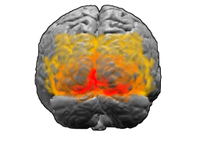
Photo from wikipedia
Natural environments consist of multiple objects, many of which repeatedly occupy similar locations within a scene. For example, hats are seen on people's heads, while shoes are most often seen… Click to show full abstract
Natural environments consist of multiple objects, many of which repeatedly occupy similar locations within a scene. For example, hats are seen on people's heads, while shoes are most often seen close to the ground. Such positional regularities bias the distribution of objects across the visual field: hats are more often encountered in the upper visual field, while shoes are more often encountered in the lower visual field. Here we tested the hypothesis that typical visual field locations of objects facilitate cortical processing. We recorded functional MRI while participants viewed images of objects that were associated with upper or lower visual field locations. Using multivariate classification, we show that object information can be more successfully decoded from response patterns in object-selective lateral occipital cortex (LO) when the objects are presented in their typical location (e.g., shoe in the lower visual field) than when they are presented in an atypical location (e.g., shoe in the upper visual field). In a functional connectivity analysis, we relate this benefit to increased coupling between LO and early visual cortex, suggesting that typical object positioning facilitates information propagation across the visual hierarchy. Together these results suggest that object representations in occipital visual cortex are tuned to the structure of natural environments. This tuning may support object perception in spatially structured environments. NEW & NOTEWORTHY In the real world, objects appear in predictable spatial locations. Hats, commonly appearing on people's heads, often fall into the upper visual field. Shoes, mostly appearing on people's feet, often fall into the lower visual field. Here we used functional MRI to demonstrate that such regularities facilitate cortical processing: Objects encountered in their typical locations are coded more efficiently, which may allow us to effortlessly recognize objects in natural environments.
Journal Title: Journal of neurophysiology
Year Published: 2018
Link to full text (if available)
Share on Social Media: Sign Up to like & get
recommendations!